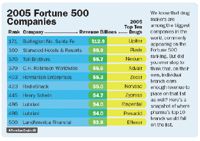Back Page: Pharma's Mega-Brands
Pharmaceutical Executive
Almost $60 billion of the drug industry's global sales comes from just 10 drugs. In fact, these so-called "mega-brands" have sales so high that they are bigger than many Fortune 500 companies. So why aren't they being managed that way?
Almost $60 billion of the drug industry's global sales comes from just 10 drugs. In fact, these so-called "mega-brands" have sales so high that they are bigger than many Fortune 500 companies. So why aren't they being managed that way?

Laurence G. Poli
The chart (right) illustrates the top-10 prescription drug brands for 2005, and their corresponding placement if they were ranked among Fortune 500 companies. For example, the world's best-selling drug, Lipitor (atorvastatin), generates enough sales to be ranked 171—the same as a 40,000-person railway company, Burlington Northern Santa Fe. Plavix (clopidogrel), with $5.9 billion in sales, would rank alongside Starwood Hotels and Resorts, number 360 on the Fortune 500.
Granted, these brands don't have the same staying power as typical top companies. Of the top-10 prescription drugs studied over the last five years, only Lipitor increased in sales, while the remaining top brands actually decreased.
But the comparison does illustrate that companies have cause to manage mega-brands almost like corporations within a corporation. Currently, companies may hire more staff and spend more money on mega-brands—but fundamentally, the organizational structure is similar to that of other drugs with substantially less revenue.

2005 Fortune 500 Companies
Yet multi-billion products pose different challenges—and different risks—for a company. To gain maximum value, companies should consider a structure similar to a strategic operating company, and use shadow stock metrics, such as earnings per share and return on assets. The "brand corporation" team may appoint a "CEO" that possesses the skills of an individual at a similar corporate level. It may also recruit an oversight group, similar to a Board of Directors, that consists of external experts that oversee and evaluate the brand's strategy, implementation, and outcomes. The "board" should include trustees who are experts in the functional areas of strategy, supply chain, reimbursement, and health policy.
At what point in the product's lifecycle does the brand team shift to the company management structure? Fundamental to this line of thinking is the identification of a mega-brand early in its gestation. If it follows that mega-brands are built, not born, then one might argue all brands under defined conditions have the potential to develop into mega-brands. This considered, brands earmarked for such status should take a structure similar to whole companies, beginning with the start-up entrepreneurial team early in its lifecycle and transitioning to a mature corporate management group as the product makes it way into the market.
Bigger Brands In 2002, a drug needed sales of $2.7 billion to break into the top-10 brands, while in 2005, it needed $3.8 billion. The top-10 drugs' collective revenue increased 21 percent from 2004 to 2005—compared with just two percent from 2002 to 2003.
Laurence G. Poli is managing partner of the Center for Performance Excellence, LLC. He can be reached at lgpoli@rxmarketing.net

The Misinformation Maze: Navigating Public Health in the Digital Age
March 11th 2025Jennifer Butler, chief commercial officer of Pleio, discusses misinformation's threat to public health, where patients are turning for trustworthy health information, the industry's pivot to peer-to-patient strategies to educate patients, and more.
Navigating Distrust: Pharma in the Age of Social Media
February 18th 2025Ian Baer, Founder and CEO of Sooth, discusses how the growing distrust in social media will impact industry marketing strategies and the relationships between pharmaceutical companies and the patients they aim to serve. He also explains dark social, how to combat misinformation, closing the trust gap, and more.